The young, rather homely yet grand gentleman is lounging under a tree, behind him a formal knot garden. His costume is extravagant and rich, and his hat is charming. This exquisite 1590s miniature by Isaac Oliver, watercolour on vellum, titled indeed A Young Man Seated Under a Tree, is the first depiction in art of a knot garden; flowers and plants by the tree are meticulously detailed, and in the background is the classic Renaissance knot garden.
It is but one among many almost unimaginable treasures, all from the Royal Collection, which tell us the history of the landscaped garden from its origins in the Middle East and India to the western obsession over the past 400 years or so. Indeed we begin with gorgeous Mughal miniatures from Indian manuscripts, depicting the court at play in meticulously arranged pavilions and walled gardens.
The idea of the garden figures substantially in myth, legend and religion: monotheism of course started in the middle east, so it is appropriate that Jan Brueghel the Elder sets the scene, so to speak, with Adam and Eve in the Garden of Eden,1615 (main picture): the tiny figures of the human protagonists are almost ghostlike in the deep background, as all kinds of animals, a veritable menagerie, from lions to hares, swans to monkeys, parrots and stags, disport themselves in a vast forested vista.
Perhaps even now we may be monarchs over our tiny suburban patch
We are accustomed to seeing the Virgin too set within a landscaped background from the Renaissance on, and early 16th-century etchings by Dürer show such scenes. As Lorenzo de Medici himself remarked in the 15th century, “Paradise means nothing more than a most pleasant garden, abundant with all pleasing and delightful things, of trees, apples [back to Eden, anyone?] flowers, vivid running waters, song of birds, all the amenities dreamed of by the heart of man.”
But the garden, perhaps above all, embodies human power, the subjection of nature to man. It came to mirror the power of the state. Perhaps even now we may be monarchs over our tiny suburban patch, while in the 21st century the royal parks of London are open to the populace.
This exhibition as the Royal Collection does so well to emphasise the decorative arts – porcelain, Fabergé flowers, documents, books, furniture, a glowing chandelier which its all-blossoming glass – as well as paintings, drawings and prints, regarding all media as equal, defined only by quality, historic interest, and – we hope – at times by both.
But the strength of the fine arts in this anthology is more historic than aesthetic, with even some of the inescapably great, such as Rembrandt, represented by less than masterpieces. Even earlier, the huge horizontally orientated The Family of Henry VIII, c.1545, (by anonymous, aka British School; pictured below) is, we are told, the first time a real garden (Whitehall Palace) was depicted in British art, as opposed to the tiny, idealised gestures towards divine – and courtly – gardens in illuminated manuscripts. Henry of course had confiscated the gardens – Hampton Court and Whitehall Palace - of that other potentate, Cardinal Wolsey. Improbable as it might seem Henry was a hearty walker.
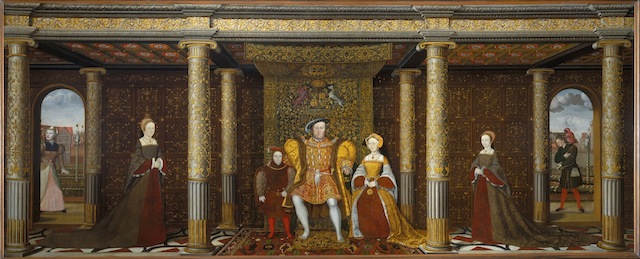 So gardens became expressions of the power of the rich and the powerful propaganda for the royals: think Versailles. A fascinating sequence of paintings are perspectives of the formalities of the planned gardens of the great. Here is Pozzoserrato’s 16th-century Pleasure Garden with a Maze, Leonard Knyff’s early 18th-century A View of Hampton Court maze, Johan Schalch’s The Gardens at Kew, 1760.
So gardens became expressions of the power of the rich and the powerful propaganda for the royals: think Versailles. A fascinating sequence of paintings are perspectives of the formalities of the planned gardens of the great. Here is Pozzoserrato’s 16th-century Pleasure Garden with a Maze, Leonard Knyff’s early 18th-century A View of Hampton Court maze, Johan Schalch’s The Gardens at Kew, 1760.
And along the way, collecting plants began and the science of horticulture. These interests sparked beautiful illustrated books, the florilegia, superb watercolours of treasured plants from particular collections. It took 30 years to complete the amateur collector, gardener and artist Alexander Marshal’s Florilegium (1650-1682): roses, love-in-a-mist, tulips, narcissi and auricula and even a snail, species unknown, are entrancingly depicted, with the artist’s passionate attention to botanical detail beguilingly conveyed.
A range of 18th century porcelain from Sévres to Meissen to Chelsea give us dishes with beautifully painted floral decorations, and plates and containers in the actual shape of vegetables and fruit. There is an enormous piece of Vincennes, The Sunflower Clock, in the shape of a vase with an over-the-top bouquet of flowers in soft paste porcelain: they could be removed to put real flowers according to season in the vase, the whole mounted in a floral motif set of brass candle holders.
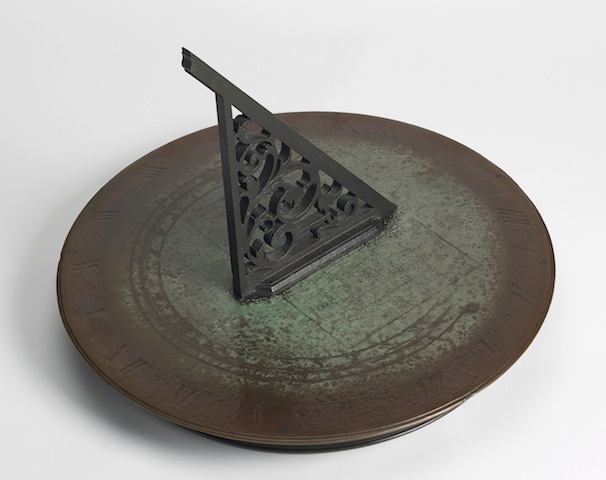 There are big free-standing tin glazed Dutch tulip vases, tapestries, tables festooned with carved and engraved garlands, sundials by Thomas Tompion (one of a pair of sundials pictured left), Fabergé flowers in rock crystal vases. One rather subtly disturbing set of Victorian jewels is a pair of gold mounted enamel earrings and a pendant in the shape of fuchsias, set with the milk teeth of Princess Beatrice: an incisive display of the Victorian interest in superb craftsmanship, with a touch of kitsch.
There are big free-standing tin glazed Dutch tulip vases, tapestries, tables festooned with carved and engraved garlands, sundials by Thomas Tompion (one of a pair of sundials pictured left), Fabergé flowers in rock crystal vases. One rather subtly disturbing set of Victorian jewels is a pair of gold mounted enamel earrings and a pendant in the shape of fuchsias, set with the milk teeth of Princess Beatrice: an incisive display of the Victorian interest in superb craftsmanship, with a touch of kitsch.
The 19th century gives us Edwin Landseer’s Windsor Castle in Modern Times, 1840-43, (pictured below) with Victoria and Albert gazing out at their formal garden, with the more informal glories of Windsor Park beyond. The family group includes four dogs, six dead game birds, and the infant Princess Royal as well.
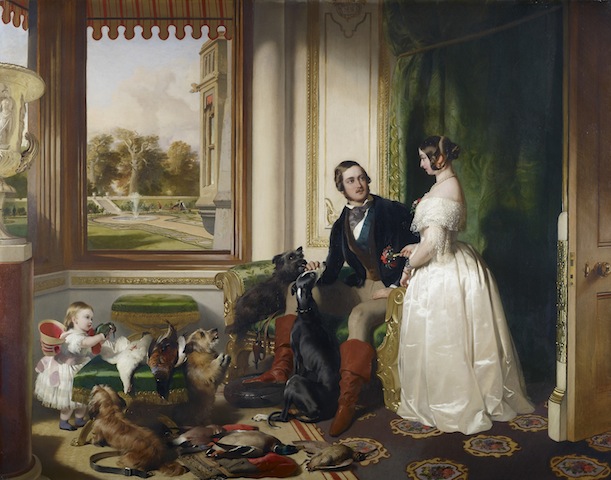 Victoria herself commissioned the tour de force of the Danish artist Laurits Regner Tuxen’s The Garden Party at Buckingham Palace, 28 June 1897, which took three years to finish. The occasion was Victoria’s Diamond Jubilee; we see the Queen, nearly 80, a small black figure, in her open carriage drawn by two cockaded grey horses. She is accompanied by Princess Alexandra, the Princess of Wales; the dense crowds – the Establishment in full cry – part to let them through.
Victoria herself commissioned the tour de force of the Danish artist Laurits Regner Tuxen’s The Garden Party at Buckingham Palace, 28 June 1897, which took three years to finish. The occasion was Victoria’s Diamond Jubilee; we see the Queen, nearly 80, a small black figure, in her open carriage drawn by two cockaded grey horses. She is accompanied by Princess Alexandra, the Princess of Wales; the dense crowds – the Establishment in full cry – part to let them through.
There is the sacred garden of the imagination, including prints by Dürer of the Madonna at ease on a garden bench. There are scientific investigations, exemplified by drawings by Leonardo; and in plan and painting, there are the gardens themselves, from the formality of the Renaissance and Baroque, to the contrived naturalism of the picturesque.
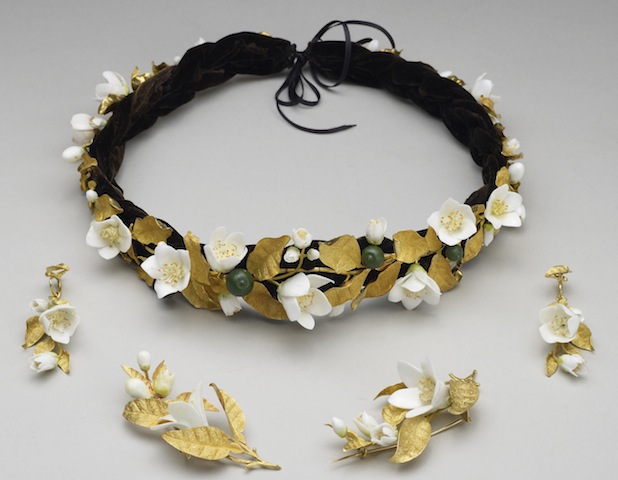 There is also the complicated language of flowers so beloved in the 19th century – orange blossom, for instance, meant chastity, and was the only flower worn by Victoria when she married Albert. On view is the suite of orange blossom jewellery (pictured right) – headdress, earrings, brooches, in gold porcelain and enamel – presented over several years by Albert to his wife, which Victoria always made a point of wearing on their anniversary. The notion of the garden now does seem a very English love affair.
There is also the complicated language of flowers so beloved in the 19th century – orange blossom, for instance, meant chastity, and was the only flower worn by Victoria when she married Albert. On view is the suite of orange blossom jewellery (pictured right) – headdress, earrings, brooches, in gold porcelain and enamel – presented over several years by Albert to his wife, which Victoria always made a point of wearing on their anniversary. The notion of the garden now does seem a very English love affair.
The whole is a sumptuous anthology, looking at the different ways the natural world, altered and cultivated, has appeared over several centuries.

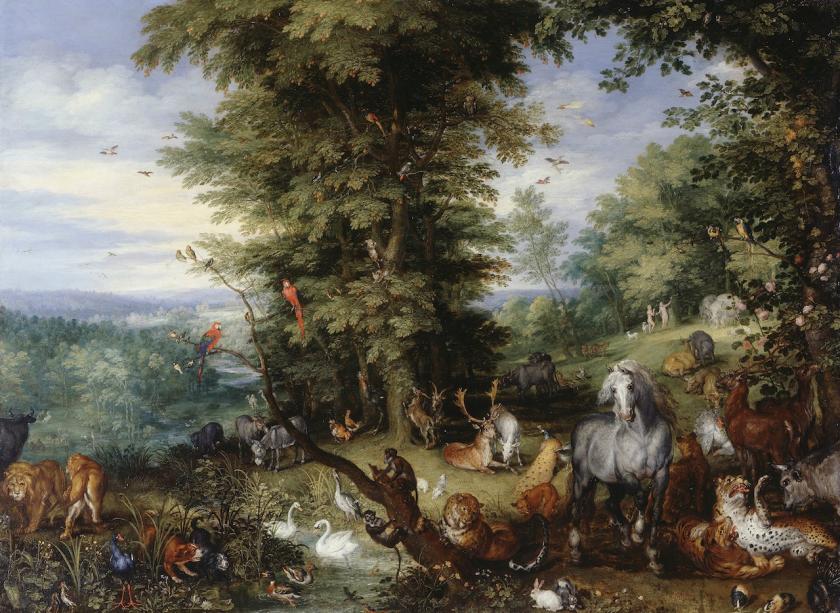








![SEX MONEY RACE RELIGION [2016] by Gilbert and George. Installation shot of Gilbert & George 21ST CENTURY PICTURES Hayward Gallery](/sites/default/files/styles/thumbnail_125_x_125_/public/mastimages/Gilbert%20%26%20George_%2021ST%20CENTURY%20PICTURES.%20SEX%20MONEY%20RACE%20RELIGION%20%5B2016%5D.%20Photo_%20Mark%20Blower.%20Courtesy%20of%20the%20Gilbert%20%26%20George%20and%20the%20Hayward%20Gallery._0.jpg?itok=3oW-Y84i)




Add comment